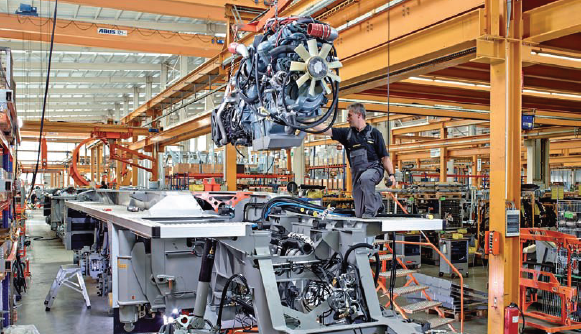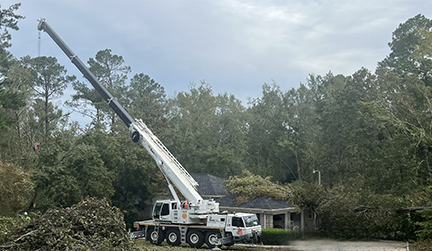
What’s under the hood of a crane is always important, but as engine regulation has increased the critical details of the engine become even more crucial. Zak Garner-Purkis looks at one of the most affected markets, all-terrain cranes.
Cranes components seldom come from one source alone, with different parts of these machines coming from a variety of sources and manufactured by a range of companies. There are few more important examples of this than the engine of an all-terrain crane.
With the exception of Liebherr, all the major manufacturers of this type of crane use engines developed by specialists who they work with to tailor to the needs of the machine they are making.
The engine of an all-terrain crane has always been an area that crane buyers and owners focus upon for obvious reasons, the nature of the crane means that versatility and efficiency are key. The engine must be able to function as well on the jobsite as it does on the road. In recent years engine regulation both on the road and on the jobsite has brought even more focus to the engines of these cranes.
A partnership
The process of developing the right engine for an all-terrain crane is a long and complex process. Normally relationships are built up over many years with changes planned years in advance. Changes in regulation are anticipated by the two manufacturers and solutions conceived to maintain capacity and efficiency whilst also complying with regulation.
Engine manufacturer Volvo Penta works closely with several manufacturers to ensure that they produce the best possible machine as Darren Tasker, director industrial business, Volvo Penta Region America explains: "Most crane manufacturers source engines and power systems from engine suppliers. There are no ownership relationships. There is a need of a very close collaboration between engine supplier and crane manufacturer in order to get a well-functioning power train."
"A crane is in need of an engine that can govern the sensitive movements needed in a very precise way. Therefore the governor characteristics need to be very accurate and tunable so that the load can be moved in a precise and safe manner. Modern electronically controlled engines are ideally suitable for this type of governing.
"Many crane manufacturers operate globally and are in need of an engine supplier that has products that can be used anywhere, in any country. This means that an engine installation preferably shall be possible to use both in non-regulated and regulated markets."
One of the few crane manufacturers that makes its engines completely in house is Liebherr. The company therefore has a unique vantage point from which to measure engine development, Wolfgang Beringer head of sales promotion at Liebherr-Werk Ehingen describes how the company has found the shifting regulatory landscape: "The cooperation between the crane manufacturer and the engine manufacturer has to be very close as for many years both have had to work permanently on fulfilling new emissions standards.
"The time between the last exhaust emissions standard 97/68/ EC IIIB and Tier 4 interim in the USA and the new Stage IV/Tier 4 final (valid from 1 January 2014) was just 3 years. Work on implementing the old exhaust emissions standard had only just been completed when the first activities towards fulfilling the successor standard were initiated.
"Diesel engine manufacturers are hardly able to keep up with the speed of these steps, so that when we convert a machine, we initially have to plan and design it with engines which have not yet been fully developed. The design, construction, conversion and testing effort is gigantic and has been dominating the production of mobile cranes in many areas for years."
Cummins are another engine maker who collaborate closely with crane manufacturers to produce efficient regulation-compliant machines. One firm that the company works with on all terrain cranes is the US manufacturer Link Belt. The crane manufacturer made its design decisions in partnership with the engine maker and decided to use one engine rather than two on the crane as Kevan Browne, Cummins' communications director explained: "Link-Belt chose to use two Cummins engines rather than a single engine in its all-terrain crane design. The use of an upper industrial engine specified for crane operation and a lower truck engine for transport means that the ideal engine configuration is installed to power each of these key functions - rather than compromising performance by using a single engine.
"The lower engine in the ATC- 3210 is a Cummins ISX15 for crane mobility with a 564 hp (421 kW) output, meeting the EPA 2013 and Californian on-highway near-zero emissions standards. The ISX15 is the most widely used heavy-duty truck engine in North America, providing the power needed for relaxed high speed travel and instant torque for climbing steep roads or enhanced mobility on difficult job sites. The 15-liter engine comes with an integral engine compression brake and cruise control. The ISX15 also complies with 2014 EPA greenhouse gas and U.S. Department of Transportation (DOT) fuel efficiency standards."
Size and weight
Tough economic conditions in certain regions have heightened the importance of versatile machinery. All terrain cranes are just one type of equipment that has become more useful for firms at these times of difficulty. The engines of these cranes are important too because they need to function as well on road and off road. Regulation has presented a range of challenges for such machines and manufacturers have different solutions.
One particular consideration with new engines as Darren Tasker from Volvo Penta explains: "Installation space is usually critical in an all-terrain crane. Having a solution with as little complexity as possible makes it easier for a crane manufacturer to install an engine, being non-regulated or Tier 4 Final. Volvo Penta has chosen to develop a specific aftertreatment for non-road applications with as little complexity and maximized uptime as possible, using only SCR and avoiding: heavy cooled EGR, DOC and DPF.
"The highly regulated engines are normally not suitable to use together with high sulphur diesel. This makes it necessary for OEMs to use different engine specifications for different markets."
Installation requirements are also important issues to take care of. Nowadays more and more engine manufacturers move towards in-line engines and this will be the most common engine configuration in the future. Across its range of engines Liebherr has also found weight to be an important issue, Wolfgang Beringer explains: "Besides the performance requirements, weight is of great importance for mobile and crawler cranes. In addition, the available installation space for the engine plays an ever increasing role as current and upcoming emission limits for diesel engines can only be met by complex exhaust gas after treatment. Especially in mobile cranes there is little to no room for this. Engine and crane development teams have to find a suitable installation position, with enough space and where the proper functioning of the exhaust gas after treatment system can be ensured with the required efficiency.
"Weight increases caused by the introduction of the new exhaust emissions standards Stage IIIB and IV (Tier 4 Interim and Tier 4 Final) can be partially compensated for in the configuration of the cranes, but additional lightweight construction measures are also required. Weight can be saved, for example, by implementing optimizations in the field of wheels/rims/brakes/axles.
The single-engine concept of our new models naturally also saves weight. Liebherr developed the "SCRonly" exhaust gas after treatment system for EU Stage IV and USA EPA Tier 4 Final. This works completely without exhaust gas recirculation, oxidation catalytic converter and particulate filter, making it very compact and weight-optimized. Compared to Stage IIIB and Tier 4 Interim, there is no loss of power attributable to the exhaust gas after-treatment system."
In part 2, we will discuss the regulations and the future of crane engine development industry.
Source: Cranes Today Magazine
